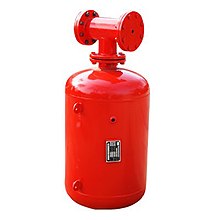Our website is made possible by displaying online advertisements to our visitors.
Please consider supporting us by disabling your ad blocker.
Air blaster
This article includes a list of references, related reading, or external links, but its sources remain unclear because it lacks inline citations. (April 2009) |

An air blaster or air cannon is a de-clogging device with two main components: a pressure vessel (storing air pressure) and a triggering mechanism (high speed release of compressed air). They are permanently installed on silos, bins and hoppers for powdery materials, and are used to prevent caking and to allow maximum storage capacity. They are also used in the film and theatre industries to project simulated debris from explosions, and as surprise effects in Halloween haunts and other attractions.
Air blasters do not need any specific air supply. Available plant air is enough with a minimum of 4 bar air pressure (60 psi or 400 kPa), although 5 to 6 bar are preferred for better results (75 to 90 psi). The average air consumption is moderate, and depends on the number of firings per hour, size of the pressure vessel, and number of blasters installed. For instance, a 50-liter air blaster consumes 0.60 Nm³/hour at 6 bar air pressure (90 psi or 600 kPa), with 2 firings per hour.
When the air in the pressure vessel is quickly released, the blast, called the impact force, evacuates material sticking to the container's walls (referred to as "rat holing"), and breaks potential accumulation points for subsequent clogging ("bridging"). The blasts are usually programmed with an automatic sequencer.
Previous Page Next Page


